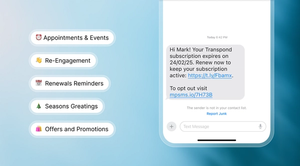Many small business owners assume a social media strategy requires months to develop, a big budget to execute, and expert skills to manage. They put it off, thinking they need perfect branding or a dedicated marketing team to get it right.
But here’s the truth: a simple, well-structured plan is enough to get results.
With just an hour of focused effort, you can create a social media strategy that fits your business and supports your goals. This guide will walk you through how to choose the right platforms and map out content that keeps you visible without draining your time.
Why social media matters for small businesses
Ignoring social media isn't an option anymore. Small businesses that use it strategically see stronger brand recognition, higher engagement, and increased sales – all without massive ad budgets. Here’s why:
1. Your customers are already there
Social media is where people spend their time. Over 5.24 billion people actively use social platforms worldwide, and 77% of small businesses say social media helps them attract new customers. If your business isn’t showing up, your competitors will.
2. It’s a discovery engine for small businesses
Social media drives buying decisions. 57% of consumers discover new brands through social media, and 78% of Gen Z say they’ve bought a product after seeing it on a platform like TikTok or Instagram. Even if you don’t sell directly online, showing up consistently keeps your business top of mind.
3. It’s free (or close to it) compared to traditional marketing
Unlike paid ads, trade shows, or print media, social media lets you reach potential customers with little to no upfront cost. Organic social media marketing can help grow small businesses without increasing expenses. Even when businesses invest in ads, platforms like Facebook and Instagram can generate an even 10:1 return on investment when done right.
4. Conversations turn into conversions
Social media is one of the few marketing channels where you can interact directly with customers. 71% of consumers who have a positive experience with a business on social media are likely to recommend it to others. Answering questions, sharing stories, and engaging with comments build real relationships – and real relationships drive sales.
Your audience is already scrolling – make sure they’re scrolling past your content. A simple, consistent presence can make all the difference.
Creating your social media strategy: step-by-step
Step 1: Define your goals and audience (15 mins)
Before you start posting, get clear on what you want to achieve and who you’re trying to reach. Without this, you’ll end up posting random content—wasting time without real results.
Good news? You don’t need a deep dive into data or a complicated spreadsheet. A few clear goals and a basic understanding of your audience are enough to set you up for success.
Set goals that actually drive results
What’s your goal for using social media? More followers? Leads? Website traffic? Brand awareness? Be specific—vague goals lead to vague results.
Make it SMART:
- Specific – What do you want to achieve?
- Measurable – How will you track success?
- Achievable – Is this realistic?
- Relevant – Does it align with your business?
- Time-bound – When will you reach this goal?
Example:
Instead of 'Get more followers,'
Set:
'Grow our Instagram audience by 200 in three months by posting 3x a week and engaging with five accounts daily.'
Take action: Write down one SMART goal. Keep it simple but concrete.
Find your audience without overthinking It
Your audience is already online – you just need to show up where they are. To figure that out, answer these three quick questions:
Who are my current customers? Are they small business owners, parents, students? Look at your existing buyers for clues.
What problems do they want to solve? Are they looking for quick service, business advice, or creative inspiration? Your bakery’s customers might be after the latest viral treat – like butter boards with fresh sourdough – or a picture-perfect cake for a special event.
Where do they spend time online?
- Check your website analytics → Tools like Google Analytics show you which social platforms send traffic your way. For example, if Instagram is a top referrer, that’s a strong signal your audience is active there.
- Look at competitors → See where similar businesses get the most engagement. If your competitors are getting strong interaction on LinkedIn but crickets on Twitter, you know where to focus.
- Ask your customers → Run a quick poll via email or your existing social media. A simple 'Which platform do you check daily?' can give you a clear direction.
You don’t need a detailed persona – just a rough idea of who they are, what they need, and where they scroll.
Step 2: Pick your platforms (10 minutes)
You don’t need to be on every social media platform – just the right one(s) for your business. Spending time where your customers already are will give you better results with less effort.
Use this quick guide to decide where to focus:
| Platform | Best for | Why it works |
|---|---|---|
Local businesses, service providers, community engagement | Easy to build an audience through groups, reviews, and local targeting. | |
Visual brands, eCommerce, lifestyle, food, fashion | Great for photos, reels, and influencer collaborations. | |
B2B services, consultants, personal brands | Best for authority-building and networking. | |
TikTok | Gen Z & Millennial brands, fun/creative businesses | High engagement with short-form videos. |
DIY, home decor, fashion, recipes | Ideal for content that gets saved & searched. | |
Youtube | Education, tutorials, long-form content | Suitable for in-depth content and SEO benefits. |
X (Twitter) | News, real-time updates, tech & SaaS brands, thought leadership | Best for quick updates, trending conversations, and industry networking. |
How to choose the right platforms?
- Go where your customers are. Selling to businesses? Start with LinkedIn. Targeting local buyers? Facebook is a good bet.
- Match it to your content style. If you prefer writing, LinkedIn might be a good fit. If you love short videos, try TikTok.
- Start small. Focus on one or two platforms first. You can expand later when you have more time and resources.
Private vs. business profiles: Don’t make this mistake
Never use your personal profile for business. Instead, set up a Business Profile (it’s free and comes with extra tools).
Why?
You can run ads. Private profiles can’t promote posts or run paid campaigns – only business profiles can. Even if you don’t plan to use ads now, having the option in the future may come in handy.
You get analytics. Business accounts provide insights into reach, engagement, and audience demographics – private profiles only show basic metrics like likes or comments.
It looks professional. Customers expect to message a business page, not send a friend request to your personal account. Keeping business and personal life separate builds credibility.
How do you set up a business profile?
- Facebook: Step-by-step guide
- Instagram: Convert to a business account
- LinkedIn: Create a company page
- TikTok: Switch to a business account
Step 3: Create a simple posting plan (20 minutes)
Social media shouldn't take up a huge chunk of your time But without a plan, it quickly turns into one.
A simple content strategy helps you stay consistent, engage your audience, and avoid last-minute scrambling.
Keep things simple and focus on what to post, how often, and when to schedule it – all in 20 minutes.
What should you post?
Different types of content grab attention in different ways. You don’t need to post everything at once – start with what feels natural for you and your business. These formats work well for small businesses, and each offers a specific benefit:
Photos
Behind-the-scenes shots, product sneak peeks, or happy customer moments. Photos help show the real side of your business. A quick snap of a busy day, a freshly packed order, or even a messy workspace tells a story customers relate to.
Why it works: It builds trust. People like to buy from businesses that feel human.
Videos
Quick tutorials, product demos, or day-in-the-life clips.
Videos stop the scroll. Whether you’re explaining how your product works or just showing your morning prep routine, videos bring motion and energy to your feed.
No need to create long videos! Use Reels – short, vertical videos that catch attention fast. Think product-in-action shots, reactions to trends, or fun team moments.
Why it works: People retain 95% of a message when they watch it in a video vs. 10% when reading it. (source)
Example: Pink Elephant Bakery’s short-form baking clips turn everyday work into eye candy.
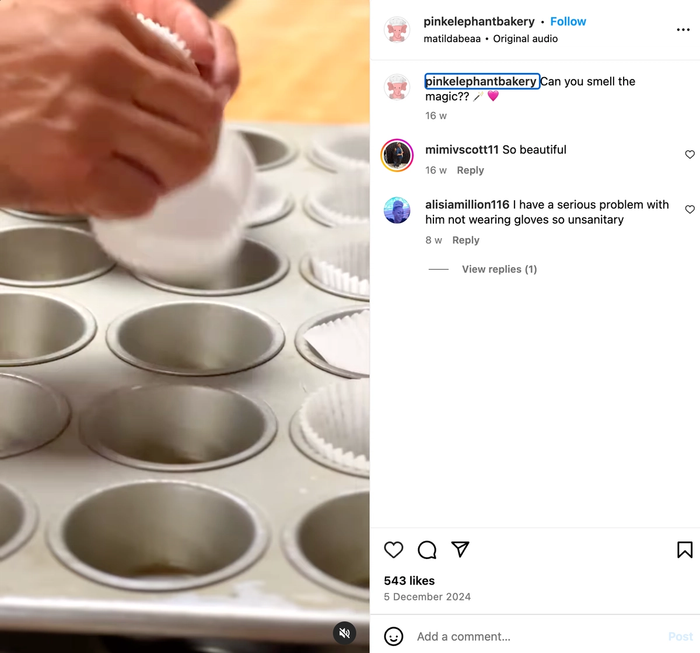
Text posts
Share short tips, thoughts, or updates. Not everything needs a photo. Thoughtful or funny text posts work well, especially on platforms like LinkedIn or X, where your voice carries the message.
Why it works: It positions you as approachable, relatable, and real.
Carousels
Step-by-step guides, visual lists, or event recaps. A carousel lets you explain something across 2–10 slides without cramming everything into one post.
Why it works: It's digestible and encourages swipes – which means more time spent on your post.
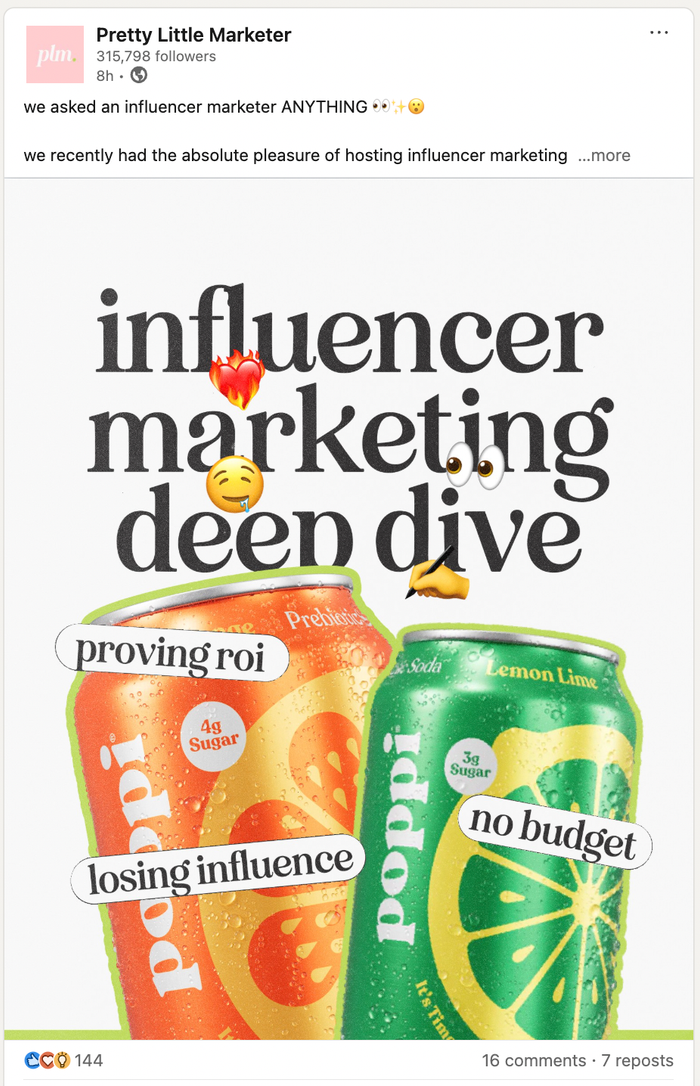
User-generated content (UGC)
Reposts of tagged customer photos, glowing reviews, or testimonials. When a happy customer shares your product, it’s social proof in its most authentic form.
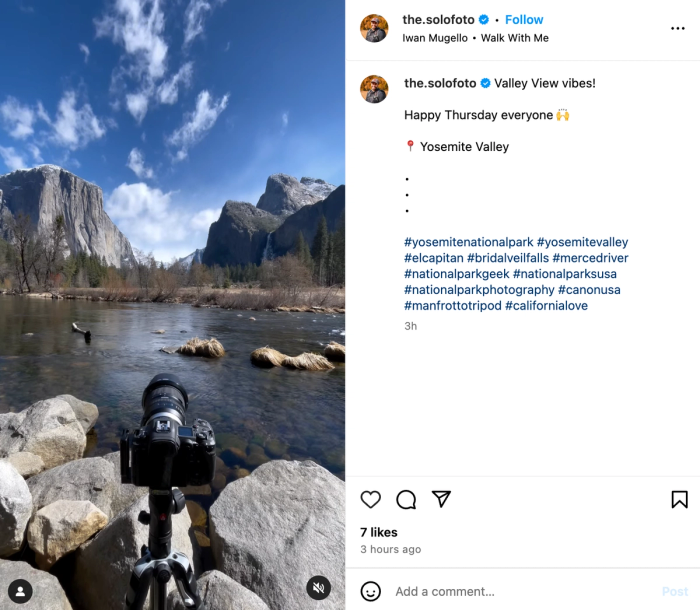
Why it works: People trust real users more than ads – UGC builds credibility and boosts trust.
Good practices
Mix up your formats
Not every audience reacts the same way to every format. Post a mix of photos, videos, carousels, and text-based posts to see what drives the most engagement. Your insights tab will tell you what’s landing.
Keep it simple, stay flexible
A plan is great. But don’t ignore the fun stuff that happens in real time! Post a behind-the-scenes moment. Celebrate a customer win. Share a funny fail. Social media is a conversation, not a broadcast. Authenticity connects and reactive content helps you stay relevant.
Check on your competitors
Look at what other businesses in your niche are posting – and how well it’s performing.
Use Meta Ad Library to see which Facebook and Instagram ads your competitors are running. For example, if you run a local optician in the UK, you can look up Specsavers and get inspired by their creative adverts:
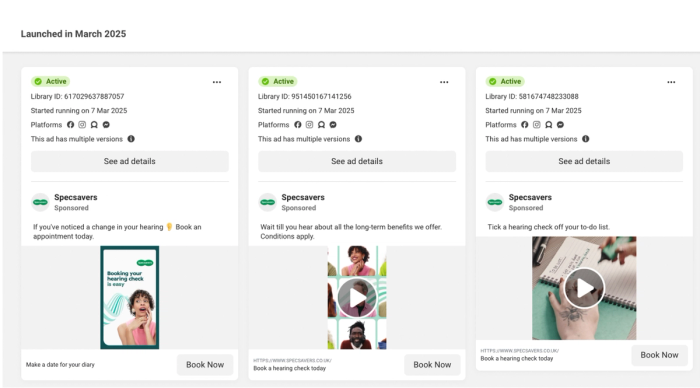
Repurpose your best-performing content
Don’t reinvent the wheel every time. Take what worked — a tip, a demo, a story — and turn it into a new format. A strong Reel can become a swipe-through guide, or a popular post can resurface months later if it’s still timely.
How often should you post?
Consistency matters more than frequency. You don’t need to post every day — just often enough to stay visible and build trust.
Here’s a simple rule of thumb: Post as often as you can realistically keep up with for at least 4–6 weeks. That could mean two posts a week — or one a day if you’ve got the time and ideas.
Try this starting point:
- Facebook: 2–3 times per week (photos, updates, reels)
- Instagram: 3–4 times per week (mix of posts, reels, and stories)
- LinkedIn: 1–2 times per week (tips, behind-the-scenes, thought leadership)
- TikTok: 2–4 short videos per week (fun, behind-the-scenes, casual)
- X (Twitter): 3–5 times per week (quick thoughts, product updates, retweets)
Start small and scale later. Two great posts a week are better than five rushed ones. You can always add more as you get comfortable. Also, revisit your plan monthly to look at what’s working. Double down on formats and topics that resonate — and drop what’s not landing.
Running a small business is already a full-time job — let scheduling tools lighten the load. With Transpond, you can plan your social media posts in advance and stay focused on what matters most, knowing your strategy is working behind the scenes.
When to schedule your posts
Knowing what to post is one thing. Knowing when to post? That’s how you get eyes on it.
Each platform has its own rhythm — and your job isn’t to post constantly, but to post when your audience is already scrolling. Here’s a quick guide to help you time your posts right.
Post in the morning during the workweek — especially Monday at 10 a.m., Tuesday at 9 a.m., and Friday at 10 a.m. That’s when most people are easing into their day and checking in. Evenings (7–10 p.m.) can also work well — think post-dinner scrolls.
Early birds catch the likes. Weekdays between 7–8 a.m. tend to drive the most engagement. People are checking their feed first thing in the morning. Fridays and Mondays are best, while weekends (especially Saturday) are usually quieter.
This is a 9-to-5 platform. Post between 9 a.m. and 5 p.m. on Thursdays and Fridays to reach people when they’re in 'work mode.' Skip the weekends — users typically log off.
X (Twitter)
Best engagement happens during weekday mornings, especially Tuesday and Wednesday between 8 a.m. and 12 p.m. It’s a fast-moving platform, so timing matters more than usual here.
TikTok
TikTok’s audience is active at odd hours — afternoons work well, like 2 p.m. on Mondays or 4 p.m. on Wednesdays. Surprisingly, Sunday mornings (8 a.m.) can also bring high engagement.
YouTube
Most viewers show up later in the day. Try 3–4 p.m. on Fridays, when people start winding down for the weekend and have time to watch longer videos.
👉 Remember: these are general benchmarks. Your audience might behave a bit differently — so test and tweak your schedule over time.
Step 4: Engage with your audience (10 minutes)
Posting content is just step one. To make it count, you need to be active in the comments too.
Every like, comment, or message is an opening — not just for chit-chat, but to help build trust, loyalty, and future sales. It doesn’t have to take hours. Just 10 minutes a day can make a real difference.
Why it matters?
- People want to be seen. When someone interacts with your post and hears back from you, it builds a human connection.
- Algorithms love engagement. The more back-and-forth a post gets, the more platforms show it to others.
- Feedback becomes insight. Comments reveal what people care about, what’s working, and what’s confusing.
- Engaged followers stick around. When you talk to them, they remember you. Social media platforms reward interaction. In fact, fully engaged customers spend 23% more during their lifetime than disengaged ones.
What to do in your 10 minutes?
1. Reply to comments
Even if it’s a simple 'Thanks!' it shows you’re listening. Go a step further with follow-up questions:
'Glad you loved the new cookies! Which one should we bring back next week?'
2. Respond to DMs
If someone asks a question, answer it. If they compliment you, acknowledge it. You don’t need long replies — just timely, human ones.
3. React and comment on others’ posts
Support other small businesses, regular customers, or creators in your space. This helps you show up in other feeds and keeps your presence authentic, not overly self-promotional.
4. Keep it real, not robotic
Don’t slip into corporate-speak. You’re not writing a press release — just talking to people.Instead of:
'Thank you for your message. We appreciate your interest.'
Try:
'Hey! Really appreciate you reaching out — we’d love to help.'
Small brands doing it right
Sugar and Sloth, a UK stationery brand, is a great example — the founder replies to hundreds of comments with humor, emojis, and warmth:
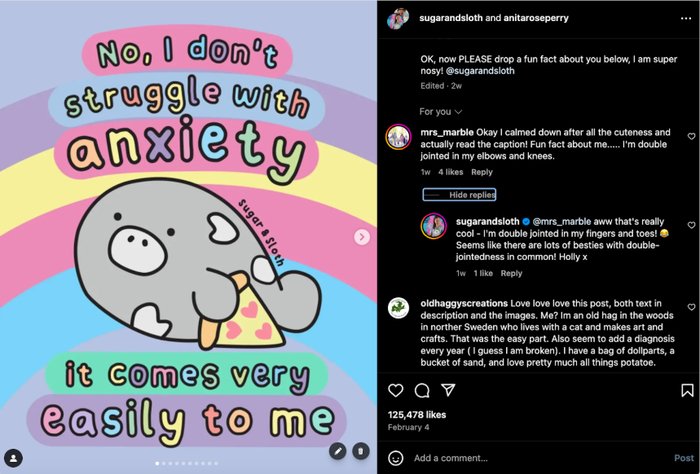
Burt’s Bees replies as if they’re your next-door neighbor, not a big corporation. That’s the tone people connect with.
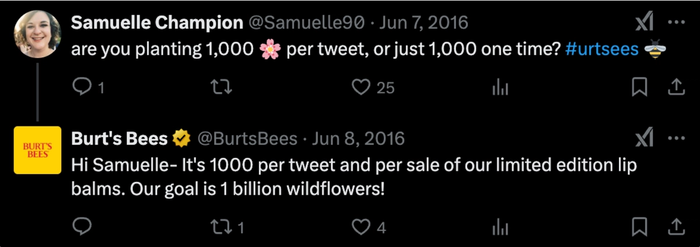
Take action
- Block 10 minutes a day for engagement — treat it like brushing your teeth.
- Reply to the last three comments or messages.
- Leave one thoughtful comment on another small business’s post.
Wrap-up: One hour, real progress
You don’t need a full-time social media manager to build a strategy that works. In just one hour, you’ve done what many small businesses delay for months — laid the groundwork for a consistent and manageable social media presence:
You picked the right platforms
You defined clear goals and audience
You built a posting plan that fits your time
You learned how to engage without getting overwhelmed
Small steps, done with intention, go a long way. You now have a system that helps you stay visible, build relationships, and grow your business — without burning out.
Next step? Set a reminder 30 days from now to review what’s working, adjust what’s not, and keep showing up. And if you need help planning what comes next, check out our small business checklist for your next move.
You started with one hour. Imagine where you’ll be in one month. Good luck!



